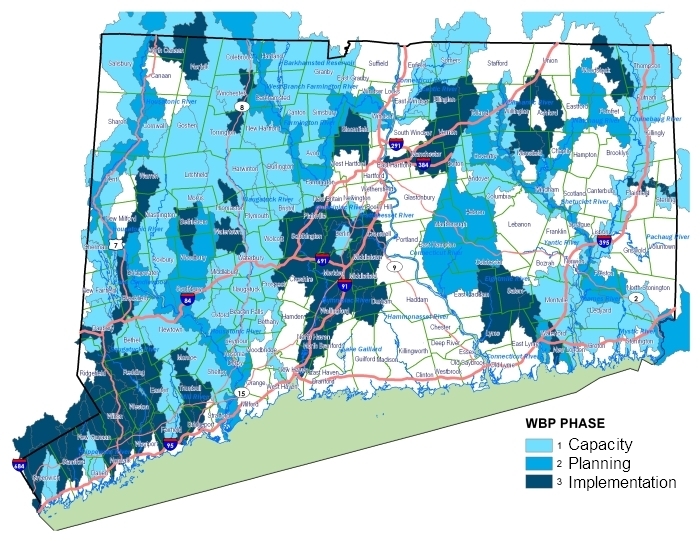Municipal Outreach for Green Infrastructure and Low Impact Development

Low impact development is an alternative way of developing land and managing stormwater that is aimed at minimizing the impacts of urbanization on natural habitats and hydrology. The creation of hardened surfaces such as roads, parking lots and rooftops in combination with culverts and other structures that alter the natural movement of water all contribute to degraded rivers and streams. The overall goal of LID is to design with nature in mind; work with the natural landscape, hydrology and unique features of a site to avoid unnecessary water pollution, environmental degradation, and flooding. LID accomplishes this by controlling runoff close to the point of generation and retaining more water on the site where it falls, rather than funneling it into pipes that drain into local waterways
DEEP has undertaken a pilot project in the Farmington River Watershed to better assess and quantify municipal barriers and how they can be best overcome.
In October 2008 DEEP invited towns in the Farmington River Watershed to apply for funding to undergo a Municipal Land Use Evaluation to identify barriers, or potential incentives to incorporating low impact development into municipal land use regulations.
Incorporation of Low Impact Development into Stormwater Permits
Stormwater Management including links to 2004 CT Stormwater Manual and 2002 CT Erosion and Sedimentation Guidelines
- Stormwater General Permits and Incorporation of Low Impact Development DEEP's study evaluating possible incorporation of Low Impact Development principles into our Stormwater General Permits includes: a detailed
- Final Report as well as:
- Low Impact Development Appendix to the Connecticut Stormwater Quality Manual and
- Low Impact Development Appendix to Connecticut Guidelines for Soil Erosion and Sediment Control
CT DEEP Program Information
Connecticut Green Infrastructure Symposium Proceedings from event held on September 19, 2013
Tools for Towns and Cities including a link to the DEEP Municipal Primer
DEEP Water Quality Planning Listserv
Subscribe to the WQPlanning listserv to receive updates pertaining to DEEP's water quality programs including: Water Quality Standards, TMDLs, Monitoring and Assessment, Watershed Management, Non-Point Source and 319 Programs, Aquifer Protection, and other water quality programs or projects.
Subscribe to the WQPlanning listserv to receive updates pertaining to DEEP's water quality programs including: Water Quality Standards, TMDLs, Monitoring and Assessment, Watershed Management, Non-Point Source and 319 Programs, Aquifer Protection, and other water quality programs or projects.
DEEP Newsletter: "Your Environmental Connection"
Watershed Management / Low Impact Development (LID) Project Examples in Connecticut: The following are examples of LID Implementation in Connecticut
Green Roofs (PDF, 3.5 MB)
Pervious Pavement (PDF, 4.8 MB)
Rain Gardens (PDF, 4.5 MB)
Rainwater Harvesting (PDF, 1.1 MB)
Green Capitols Project
- Project Brochure (PDF)
- Project Description (PDF)
DEEP Rainfall as a Resource, Low Impact Development Brochure Series
DEEP has developed a series of Brochures for Municipalities and homeowners who wish to learn more about implementing innovative stormwater controls. These brochures can be printed on legal size paper, double sided in color, and quad-folded.
2008 Resident's Guide to Low Impact Development (PDF)
2009 Resident's Guide to Rain Gardens (PDF)
2009 Resident's Guide to Rain Barrels (PDF)
2009 Resident's Guide to Pervious Pavement (PDF)
2010 Resident's Guide to Green Roofs (PDF)
2011 Resident's Guide to Vegetated Riparian Areas (PDF)
LID Tools
Links to additional resources useful to municipalities
LID techniques like:
- green roofs
- porous pavements
- grass swales
- bio-retention cells
can result in greater efficiency in costly stormwater management systems, such as storm sewers, curbs and gutters, and even some flood control projects. LID is a practice that can be used by municipalities, homeowners and developers alike. In the past few years, LID has been applied to government, residential, and commercial development and redevelopment throughout the country, and, in many cases incorporation of LID practices has resulted in significant cost savings with both construction and maintenance costs as well as efficiently managing runoff and protecting the environment.
Low Impact Development (LID) includes techniques for controlling stormwater runoff by minimizing the effective imperviousness of a site in order to create a functional and appealing landscape. There are many ways to incorporate LID into both new and old construction. The LID approach considers stormwater runoff as a resource rather than a waste product and is accomplished by incorporating features that infiltrate, filter, store and detain runoff thereby imitating the natural hydrologic conditions of a site.
By incorporating LID practices into our lives we can:
- limit runoff and improve water quality
- recharge groundwater, rivers and streams
- decrease the need for expensive stormwater systems
- create attractive developments in character with the charm of our state.
DEEP's Partners
The State of LID in Connecticut: Policies, Drivers, and Barriers
DEEP-funded projects by Connecticut Fund for the Environment and partners
- Reduce Runoff a product of the Quinnipiac River Watershed Groundwater Restoration Project
- Green Infrastructure Feasibility Scan for New Haven and Bridgeport
University of New Hampshire Stormwater Center has published a study that discusses benefits of integrating LID and traditional stormwater management for towns and commercial developers
Content last updated on February 11, 2020

